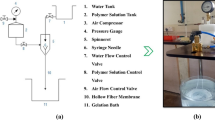Abstract
We present a study on the effects of activation on a saccharose-based carbon using molecular simulation. A constrained Reverse Monte Carlo method is used to build molecular models that match the experimental structure factors of both activated and unactivated carbon, using appropriate constraints for bond angle and coordination number to describe the three body correlation. The semi-coke sample, that is named CS1000, is obtained by pyrolyzing pure saccharose at 1000∘C under nitrogen flow. An activated form of this carbon, CS1000a, was obtained by heating CS1000 in an atmosphere of CO2 for 20 hours. We built molecular models for CS1000 and CS1000a and also simulated the TEM images of the model. We perform GCMC simulation of a Lennard-Jones model of Argon on the resulting models to obtain the adsorption isotherms. We then study the difference in the morphology of CS1000 and CS1000a that lead to different adsorption properties in carbon upon activation.
Similar content being viewed by others
References
Bandosz, T.J., M.J., Biggs, K.E. Gubbins, Y. Hattori, T. Liyama, K. Kaneko, J. Pikunic, and K. Thomson, “Molecular Models of Porous Carbons,” Chemistry and Physics of Carbon, L.R. Radovic (Eds.), Vol. 28, pp. 137–199, Marcel Dekker, NewYork,2003.
Evans, R., “Comment on Reverse Monte Carlo Simulation,” Mol. Simul., 4, 409–411 (1990).
Frenkel, D. and B. Smit, Understanding Molecular Simulation 2nd Ed., pp. 126–132, Academic Press, New-York,2002.
Gregg, S.J. and K.S.W. Sing, Adsorption, Surface Area and Porosity 2nd Ed., pp. 3–12, Academic Press, London,1982.
Gelb, L.D. and K.E., Gubbins, “Pore Size Distribution in Porous Glasses:A Computer Simulation Study,” Langmuir, 15, 305–308 (1999).
Kennedy, L.J., J.J., Vijaya, and G. Sekaran, “Effect of Two-Stage Process on the Preparation and Characterization of Porous Carbon Composite from Rice Husk by Phosphoric Acid Activation,” Ind. Eng. Chem. Res., 43, 1832–1838 (2004).
Kilpatrick, S., “Optimization by Simulated Annealing,” Science, 220, 671–680 (1983).
Marsh, H., E.A. Heintz, and F. Rodriguez-Reinoso, Introduction to Carbon Technologies, University of Alicante, 1997.
McGreevy, R.L. and L., Pustzai, “Reverse Monte Carlo Simulation:A New Technique for the Determination of Disordered Structures,” Mol. Simul., 1, 359–367 (1988).
Pikunic, J., C. Clinard, N. Cohaut, K.E. Gubbins, J.M. Guet, R.J.-M. Pellenq, I. Rannou, and J.N. Rouzaud, “Reconstruction Method for the Characterisation of Porous Carbons,” Stud. Surf. Sci. Catal., 144, 19–26 (2002).
Pikunic, J., C., Clinard, N. Cohaut, K.E. Gubbins, J.M. Guet, R.J.-M. Pellenq, I. Rannou, and J.N. Rouzaud, “Structural Modeling of Porous Carbons:Constrained Reverse Monte Carlo Method,” Langmuir, 19 (20), 8565–8582 (2003).
Pikunic, J., P. Llewellyn, R. J-M. Pellenq, K. E. Gubbins, Langmuir, submitted, 2004.
Sircar, S., T.C., Golden, and M.B. Rao, “Activated Carbon for Gas Separation and Storage” Carbon, 34(1), 1–12 (1996).
Author information
Authors and Affiliations
Corresponding author
Rights and permissions
About this article
Cite this article
Jain, S.K., Pikunic, J.P., Pellenq, R.JM. et al. Effects of Activation on the Structure and Adsorption Properties of a Nanoporous Carbon Using Molecular Simulation. Adsorption 11 (Suppl 1), 355–360 (2005). https://doi.org/10.1007/s10450-005-5950-3
Issue Date:
DOI: https://doi.org/10.1007/s10450-005-5950-3




